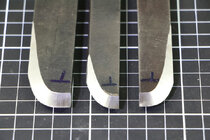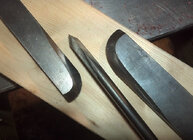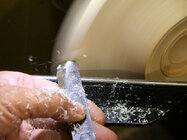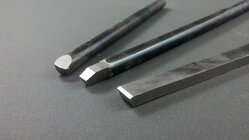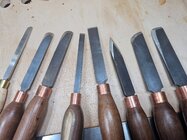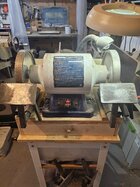I was chatting with John Jordan about stropping the skew, couldn't remember where, and he commented about sharpening his NRSs removing the burr and then burnishing the burr back up. I was introduced to the NRS at a 3 day work shop with Stuart and Allan Batty, and Allan was telling stories about turning billiard balls out of elephant ivory, a couple of years process. He was using a skew chisel. I experimented around with them a bit, and didn't really care for them that much since they were so high maintenance. Some where along the line, I started to figure that with the skew chisel variation, there just was not enough metal under the burr to support it like my Big Ugly tool which is sharpened at 70 degrees on my robo rest. So, I started to experiment. I ended up with 30/60 for the angles on my robo rest. The actual measures are 25/55 since all of my angles are 5 degrees off for some reason. Our club had Carl Jacobson demo at our club and he used D Way NRSs. Jimmy Allen, owner of D Way was using angles some what similar to mine. I did take one, and grind it to 45/45, or 40/40, can't remember, and the burr was gone in seconds, kind of like the standard skew chisel type NRSs, so I converted it back to my standard design. So, I am wondering what angles others use. For sure, the convenience of my grinder rest to exactly repeat angles makes this sharpening set up more simple than other systems. I generally just use the burr off of the grinder and it is good for several bowls rather than starting with the heel on the inside of the bowl, and going to the toe of the NRS by the time I get to the rim, and then that burr is done/gone. I can use mine for a couple of passes, then burnish the grinder burr down, then back up and I am good to go for another bowl or two, and I can do this a couple of times before needing to go back to the grinder. So, what angles do you all use out there?
robo hippy
robo hippy

